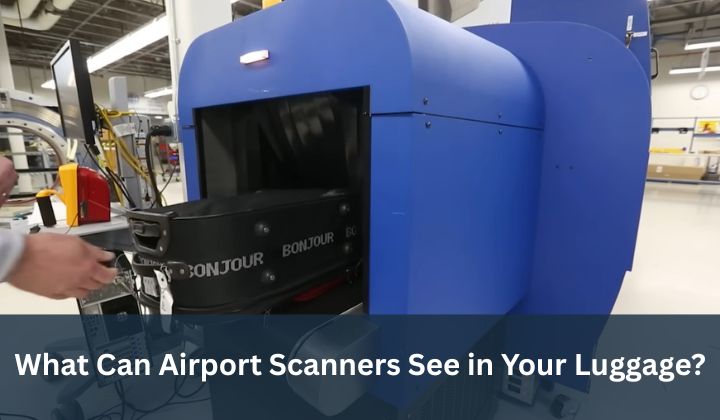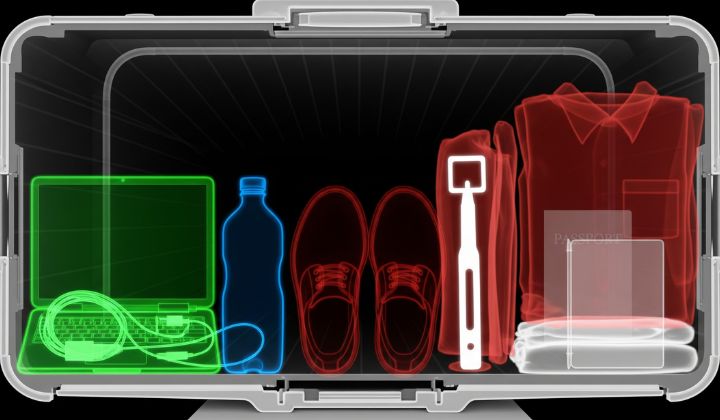Ever stood at airport security, watching your bag disappear into the scanner, and wondered, what can airport scanners see in your luggage?

This guide reveals the tech behind those X-ray machines, detailing how they spot everything from metals to organic materials.
With TSA rules, packing tips, and insider insights, you’ll learn to breeze through security, avoid delays, and keep your belongings safe on any trip, domestic or international.
How Airport Baggage Scanners Work
Airport baggage scanners are high-tech gatekeepers ensuring flight safety. Using X-ray technology, these machines penetrate luggage to create detailed images of contents based on density and atomic number.
Scanners emit X-rays from one side, which pass through your bag and are captured by detectors on the opposite side.
The resulting images display items in colors: orange for organic materials (e.g., food, plastics), blue/green for metals, and green for mixed substances.
Scanners can’t identify exact items but highlight suspicious shapes or densities. For example, a dense object like a knife appears blue, while a bundle of paper or clothing shows orange. If an anomaly is detected, security may manually inspect your bag.
Advanced computed tomography (CT) scanners, used in major U.S. airports, create 3D images for even clearer detection, though they’re slower. Understanding this process helps you pack to avoid scrutiny.
What Can Airport Baggage Scanners See?

Airport baggage scanners see detailed images of your luggage contents, detecting metallic objects (e.g., knives, guns), non-metallic items (e.g., plastics, ceramics), and organic materials (e.g., food, paper).
Using X-rays, they identify items by density and atomic number, displaying metals in blue/green, organics in orange, and mixed substances in green.
While they can’t confirm specific items like drugs, suspicious shapes or densities trigger manual inspections. Always follow TSA and airline rules to avoid delays.
What Materials Are Detected?
Airport scanners are designed to identify a wide range of materials:
- Metallic Objects: Knives, guns, and jewelry appear blue or green due to their high density. Even small items like coins or keys are easily spotted.
- Non-Metallic Objects: Plastics, ceramics, and glass show up based on density, often in green or orange hues. Plastic explosives, for instance, can be detected due to their unique density.
- Organic Materials: Food, clothing, paper, and some drugs appear orange. Scanners can’t directly identify drugs but flag large organic masses for inspection.
- Dense Materials: Thick metals like gold or tungsten may appear dark, as X-rays struggle to penetrate them, potentially triggering manual checks.
A unique insight: scanners may flag densely packed items (e.g., tightly rolled clothes) as suspicious due to their opacity, so spread items out to avoid delays.
Limitations of Baggage Scanners
While advanced, scanners have limits. They can’t directly identify substances like drugs or confirm an item’s exact nature. For example, a bottle of liquid and a solid mass may both appear orange, requiring manual inspection to distinguish. Dense materials like lead or thick metals can block X-rays, creating dark spots that prompt further checks. Scanners also can’t see inside body cavities, which is why drug smugglers may attempt internal concealment, though full-body scanners address this.
To avoid issues, don’t overpack or wrap items in dense materials like aluminum foil, as it can obscure images and raise suspicion.
Prohibited Items and Scanner Detection
Scanners are tuned to detect items banned by TSA and airlines, including:
- Weapons: Firearms, knives, and ammunition are easily spotted due to their metallic composition and distinct shapes.
- Explosives: Both metallic and plastic explosives are detectable due to their density and chemical makeup, often flagged for manual inspection.
- Liquids: In carry-ons, liquids over 3.4 ounces (100 ml) trigger alerts. Checked luggage has fewer restrictions, but large liquid containers may still prompt checks.
- Drugs: While scanners don’t directly identify drugs, large organic masses (e.g., pills or powders) appear orange, leading to inspections.
A pro tip: pack liquids and medications in clear, labeled containers to speed up inspections if flagged.
Packing Tips to Avoid Security Delays
Smart packing reduces the chance of manual inspections:
- Organize Your Bag: Avoid clutter by spreading items evenly. Dense, overlapping items can obscure scanner images.
- Label Medications: Place pills or liquid medications in original packaging with labels to clarify their purpose during inspections.
- Separate Electronics: In carry-ons, place laptops and tablets in a single layer for clear scanning.
- Use Clear Bags: For carry-on liquids, use a quart-sized, transparent bag to comply with the 3-1-1 rule.
- Avoid Dense Wrapping: Don’t wrap items in foil or dense materials, as they block X-rays and trigger checks.
A unique tip: include a small note in your checked luggage listing contents (e.g., “toiletries, clothes, souvenirs”) to assist inspectors if your bag is flagged.
International Travel Considerations
International flights involve stricter regulations. For example, the UK and Canada enforce the 100 ml carry-on liquid rule more rigorously, and some countries ban specific items (e.g., alcohol-based products in certain Middle Eastern nations). Scanners at international airports may use higher-powered X-rays, increasing detection sensitivity. Always check destination customs laws via embassy resources, as items allowed in checked luggage may be confiscated upon arrival. A lesser-known tip: pack a digital copy of TSA and airline policies to resolve disputes at foreign checkpoints.
Advanced Scanner Technologies
Modern airports are adopting advanced systems:
- CT Scanners: Used in major U.S. airports, these create 3D images for precise detection but are slower. They’re ideal for identifying complex items like explosives.
- Millimeter Wave Scanners: Common for body scanning, these detect non-metallic items under clothing and are increasingly used for luggage in some airports.
- X-ray Diffraction: Emerging technology that identifies material composition, potentially reducing false positives for items like powders.
These advancements improve accuracy but may increase screening time. Arrive early to account for potential delays at airports using CT scanners.
Risks of Non-Compliance
Packing prohibited items can lead to:
- Confiscation: Items like knives or oversized liquids are seized without return.
- Fines: TSA penalties for prohibited items range from $390 to $2,250.
- Delays: Suspicious items trigger manual inspections, delaying you and others.
- Legal Action: Smuggling drugs or weapons may involve law enforcement, especially internationally.
To avoid theft, use a TSA-approved lock for checked luggage. For valuable items, consider travel insurance to cover loss or damage during handling.
Unique Insights for Travelers
Avoiding False Positives
Dense or oddly shaped items, like a tightly packed book or layered clothing, can mimic prohibited items on scanners. Spread items out and avoid overstuffing to ensure clear images. If you carry unusual items (e.g., an urn or medical device), inform security at check-in to expedite screening.
Mailing Sensitive Items
For items like medications or valuable electronics, mailing them to your destination via USPS or FedEx avoids scanner scrutiny and baggage fees. Ensure compliance with postal regulations and destination laws.
Understanding Scanner Colors
Security personnel rely on color-coded images: orange for organics, blue/green for metals, green for mixed materials. Knowing this can help you pack strategically—avoid bundling organic items like food or powders, as they may resemble suspicious substances.
Eco-Friendly Packing
Use solid toiletries (e.g., shampoo bars) to bypass liquid restrictions and reduce scanner flags. These are TSA-compliant and less likely to trigger inspections.
FAQs About What Can Airport Baggage Scanners See
1. Can airport baggage scanners detect drugs?
Airport scanners don’t directly identify drugs but can detect organic materials, which appear orange on X-ray images. Large quantities of pills or powders may raise suspicion, prompting manual inspections. TSA officers aren’t trained to identify drugs, but customs officials may be involved, especially internationally. To avoid issues, pack medications in original, labeled containers and declare them if necessary. Research destination laws, as some countries have strict drug regulations, and use solid alternatives for toiletries to minimize scrutiny.
2. Do scanners see through metal or dense objects?
Scanners struggle with dense metals like gold, tungsten, or lead, which appear dark due to X-ray absorption. While they detect metal objects (e.g., knives, guns) clearly in blue/green, thick materials may obscure images, triggering manual checks. Avoid wrapping items in foil or dense materials, as this can mimic prohibited items. Pack metals loosely and inform security about large metal objects (e.g., tools) to expedite inspections. Use a TSA lock to secure your bag.
3. How should I pack to avoid triggering a scanner?
Organize your bag to avoid clutter, as dense or overlapping items can obscure images. Place electronics and liquids in a single layer for carry-ons, and use a quart-sized bag for liquids under 3.4 ounces. In checked luggage, spread items evenly and label medications or unusual items (e.g., “Toiletries”). Avoid foil or dense wrapping. A note listing contents can help inspectors. Use TSA-approved locks and arrive early to account for potential manual checks.
4. Can scanners detect liquids in luggage?
Yes, scanners detect liquids, appearing orange as organic materials. In carry-ons, liquids over 3.4 ounces (100 ml) violate the 3-1-1 rule and may be confiscated. In checked luggage, large liquid containers may trigger inspections due to their density. Pack liquids in clear, sealed bags to contain leaks and label them (e.g., “Shampoo”). Consider solid alternatives like shampoo bars to avoid liquid restrictions and reduce scanner flags, especially for international flights.
5. What happens if a scanner flags my luggage?
If a scanner detects a suspicious item, your bag is diverted for manual inspection. TSA officers will open it to examine contents, potentially confiscating prohibited items like weapons or oversized liquids. You may face fines ($390–$2,250) or law enforcement referral for serious violations. To minimize delays, pack neatly, declare unusual items at check-in, and carry a prepaid envelope to mail confiscated items home. Arrive early to account for potential screening delays.
Practical Tips for Smooth Screening
- Check TSA Rules: Review prohibited items and packing guidelines before travel.
- Pack Neatly: Spread items to avoid dense clusters that obscure scanner images.
- Label Clearly: Mark medications, liquids, or unusual items to assist inspectors.
- Use TSA Locks: Secure checked luggage to allow inspections without damage.
- Declare Upfront: Inform security about unique items like medical devices or urns.
- Arrive Early: Allow time for potential manual inspections, especially at busy airports.
Conclusion
Ever wondered what can airport scanners see in your luggage?
These X-ray systems detect metals, non-metals, and organic materials, displaying them in color-coded images to spot potential threats.
Pack neatly, label items, and follow TSA rules to avoid delays or confiscation.
Use solid toiletries, declare unusual items, and consider mailing sensitive belongings for a hassle-free trip.
With these tips, you’ll navigate security confidently, ensuring a safe and smooth travel experience.